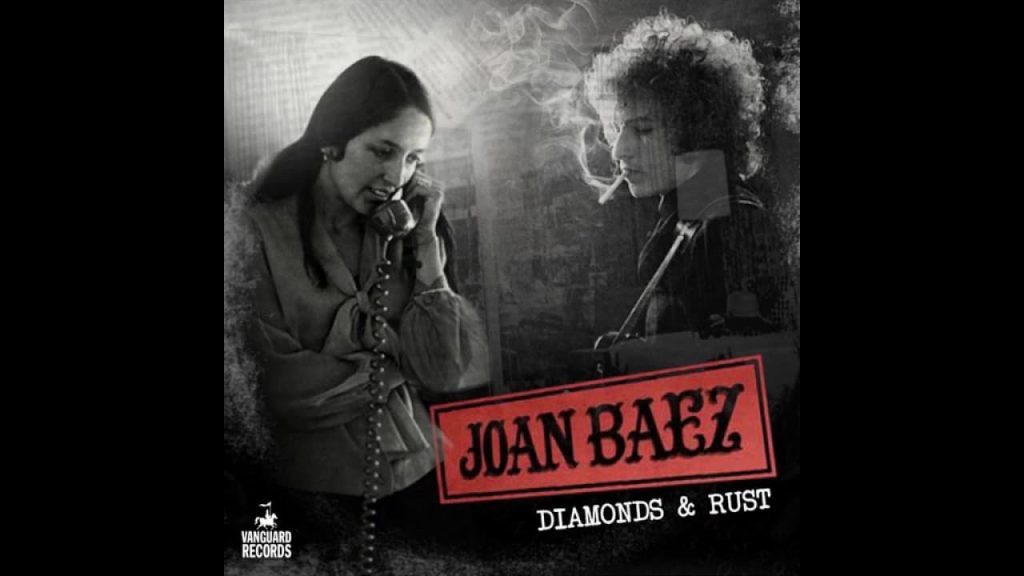
Joan Baez – “Diamonds & Rust”: A Haunting Portrait of Love, Memory, and Bittersweet Regret
“Diamonds & Rust” is not just a song—it is a confession, a love letter wrapped in heartbreak, a whispered reckoning between past and present. Written and performed by the legendary Joan Baez, this 1975 masterpiece stands as one of her most personal and evocative compositions, a poetic reflection on a love that once burned brightly but has since faded into the cold, distant glow of memory. Beneath its delicate folk arrangement lies an emotional storm—a raw, unflinching look at the way love can both shine like diamonds and decay like rust.
The song was famously inspired by Baez’s relationship with Bob Dylan, a romance that captivated the folk world in the early 1960s. Though she never explicitly named him, the references are unmistakable—the Greenwich Village hotel room, the cufflinks she gave him, the way he could “turn on a dime and give you five cents change.” More than a simple reminiscence, “Diamonds & Rust” is an exploration of how time reframes love, how nostalgia can be both beautiful and cruel. A decade after their love affair, an unexpected phone call from Dylan transports Baez back to those early days, forcing her to confront the distance between what was and what remains.
From the very first lines, the song is steeped in wistful melancholy. Baez’s voice, warm yet tinged with sorrow, draws us into her world with an intimacy that feels almost too personal to witness. The gentle acoustic strumming and subtle orchestration provide a soft backdrop, allowing the lyrics to cut through like a knife. Every word is carefully chosen, each phrase dripping with both affection and pain. When she sings about being both “taken” and “mistaken” for someone else, the ache of lost identity in love feels all too real.
The chorus—“And if you’re offering me diamonds and rust, I’ve already paid”—is devastating in its simplicity. It captures the essence of hindsight, of realizing that the dazzling beauty of love is always accompanied by its inevitable corrosion. The imagery of “diamonds and rust” is perfect: diamonds, precious and eternal, stand for the love and passion that once existed, while rust signifies the slow decay of time, the tarnishing of once-brilliant memories. Baez doesn’t reject the past, but she refuses to be consumed by it.
There is an underlying tension in the song—an unresolved push and pull between resentment and tenderness. It’s clear that Baez still holds admiration for Dylan, but she is also painfully aware of his flaws, of the emotional distance he imposed, of the way their love was never quite enough. Yet, for all the heartbreak, there is no bitterness in her voice, only a deep understanding of love’s impermanence.
Musically, “Diamonds & Rust” stands out from Baez’s earlier, more traditional folk recordings. The production is richer, more polished, blending folk with elements of soft rock. The inclusion of electric guitar and subtle orchestration gives the song a haunting, almost cinematic quality, as though the memories themselves are unfolding in slow motion. The arrangement mirrors the lyrics—at times delicate and intimate, at others swelling with the weight of emotion.
Decades later, “Diamonds & Rust” remains one of Joan Baez’s most celebrated and enduring songs. It has been covered by countless artists, including Judas Priest, whose heavy metal rendition reimagined the song in an entirely new light. Yet, no version can capture the quiet devastation of Baez’s original.
It is rare for a love song to feel so profoundly honest, to embrace both the ecstasy and the sorrow of romance with such clarity. “Diamonds & Rust” is not about regret—it is about acceptance. It is about remembering love not for what it could have been, but for what it was: fleeting, flawed, unforgettable. And in the end, perhaps that is enough.